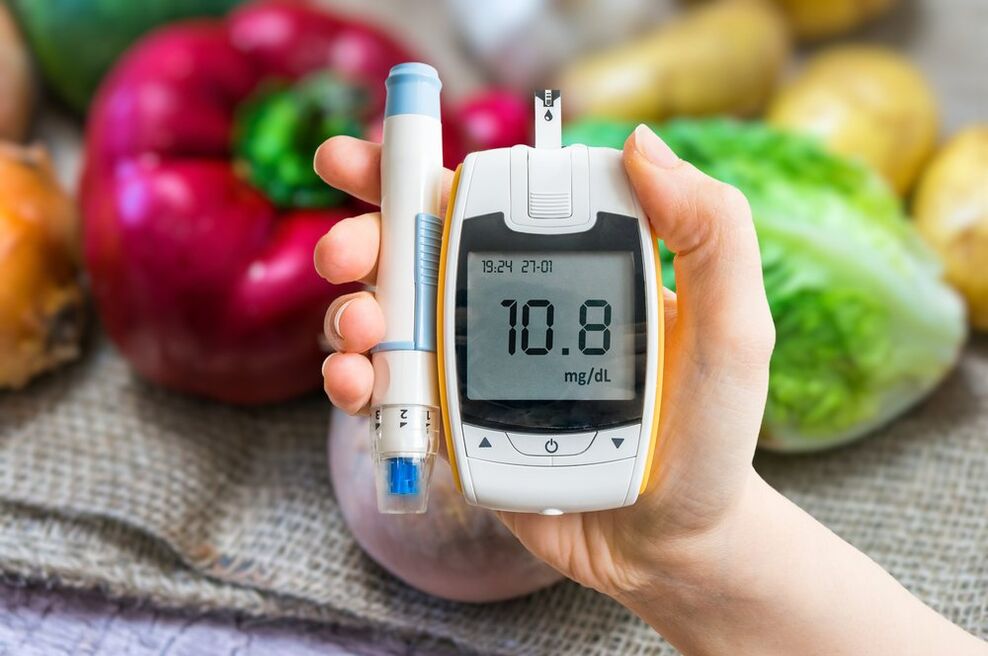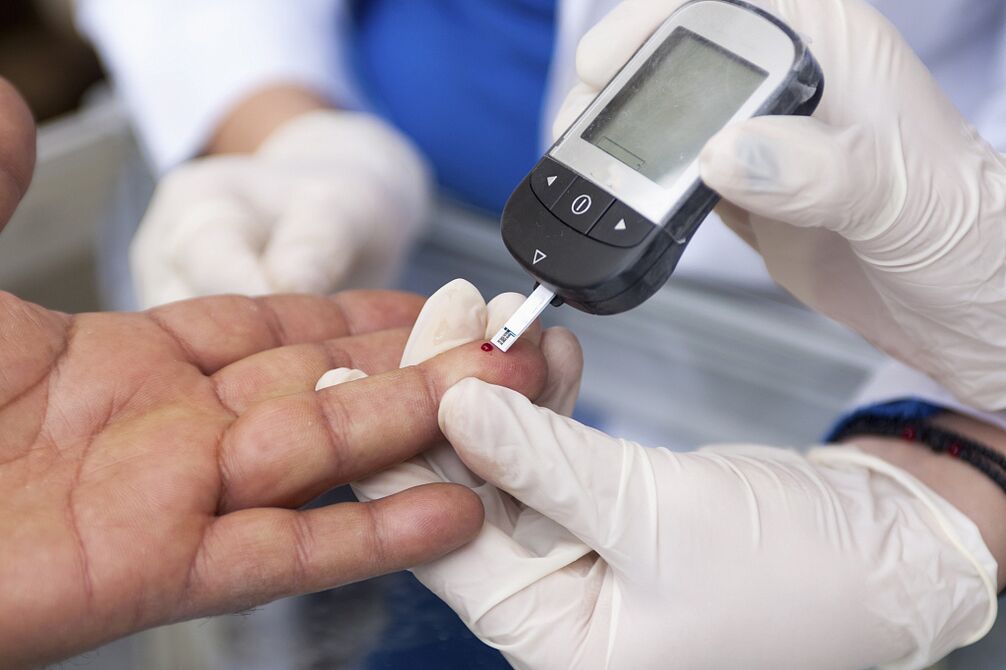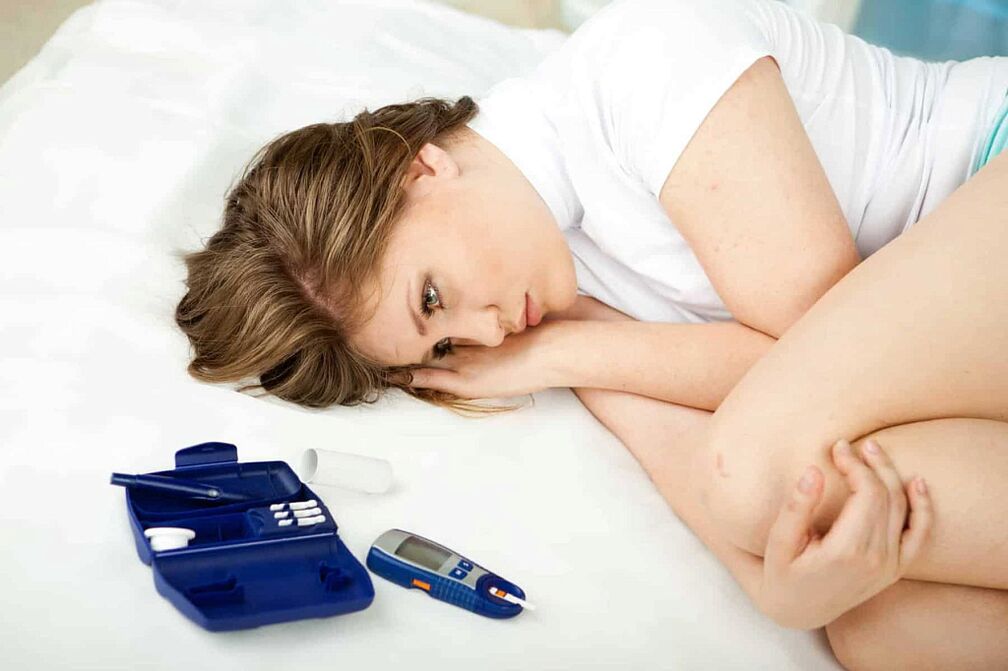
diabetes(DM) is an endocrine pathology that occurs due to insufficient insulin synthesis/action.In this context, chronic hyperglycemia arises - a condition accompanied by a persistent increase in the level of sugar (glucose) in the plasma.Hyperglycemia is a major cause of diabetes symptoms and complications: metabolic disorders, damage to blood vessels and nerve fibers, kidney failure, and blindness.
The number of diabetes cases worldwide has nearly quadrupled over the past four decades.The disease spreads fastest in underdeveloped and economically weak countries.Doctors have noticed a trend of increasing incidence in the over-40 age group.In terms of social significance, this pathology ranks third after cardiovascular diseases and cancer.
There are two main types of diabetes:
- Insulin dependence (adolescents, young adults, children),
- Insulin dependence (insulin resistance).
They have different causes, different symptoms, treatment strategies, and prognosis.Therefore, we will consider them separately in the future.
reason

Insulin is a protein hormone synthesized in the beta cells of the pancreas.Its action is achieved through insulin receptors in various organs and tissues.Diabetes occurs when beta cells are destroyed or their receptor sensitivity is reduced.
type 1 diabetes Develops in the presence of a genetic predisposition.Toxins and viral infections are the driving force behind the emergence of pathology, such as rubella, influenza, hepatitis B virus, cytomegalovirus, and retroviruses.Predisposing factors can cause acute damage to beta cells or cause infectious agents to persist in pancreatic tissue and further develop an autoimmune response.The likelihood increases if a person has other autoimmune diseases—thyroiditis, adrenocortical insufficiency, etc.
important!Diet plays a certain role in the occurrence of childhood diseases.Therefore, early exposure to gluten promotes this - it is best to introduce cereal porridge into complementary foods no earlier than 6-7 months.This risk increases when children are fed cow's milk, are deficient in vitamin D, and have high nitrate concentrations in their drinking water.
Type 1 diabetes can remain silent for many years due to our body's ability to adapt.The first sign occurs when the number of beta cells (and therefore insulin) is insufficient to regulate blood sugar levels.Type 1 accounts for approximately 10% of all pathological cases.It mainly affects children, teenagers and people under 30 years old.Less commonly, it can be found in older patients in a latent form, which is often confused with the non-insulin-dependent form.
type 2 diabetes With impaired insulin secretion and reduced insulin receptor sensitivity, otherwise "insulin resistance".The most important risk factors:
- Almost all cases have a genetic predisposition.The risk increases sixfold if a close relative has the disease.
- Obesity is usually in the form of abdominal and visceral forms, with excess fat deposited primarily in the lumbar area and/or internal organs.The risk of developing the disease increases 2-fold for obesity class I, 5-fold for obesity class II, and 10-fold for obesity class III.
Important!High-calorie foods, which are mostly simple, easily digestible carbohydrates, are thought to contribute to diabetes.These are sweets, wine, flour products, sausages, fast food, fried potatoes, soft wheat pasta.Coupled with a sedentary lifestyle and a lack of plant fiber, these foods can cause irreparable damage to the body if consumed regularly.
The second type usually occurs in adulthood.A trend has been noted: The older a person gets, the higher the concentration of glucose in the blood after a carbohydrate meal.How quickly blood sugar drops to normal levels depends largely on muscle mass and the degree of obesity.As childhood obesity is now an epidemic, an increasing number of children are developing type 2 obesity.
As in the previous case, disease occurs when the amount of insulin synthesized cannot fully compensate for the decreased sensitivity of the insulin receptors.This creates a vicious cycle: excess glucose in the blood has a toxic effect on beta cells, causing them to malfunction.
Diabetes: Symptoms of a Hidden Disease
Let us consider the clinical aspects of diabetes in terms of the disease caused by diabetes, the stage of the disease and the type of pathology.
Symptoms associated with metabolic disorders
Insulin is involved in all types of metabolism:
- Carbohydrates - regulate plasma glucose levels, as well as glycogenolysis, gluconeogenesis, and other reactions involving sugar.
- Fat - increases the synthesis of fatty acids and reduces their entry into the blood.
- Protein - Enhances protein synthesis and inhibits its breakdown, activates DNA and RNA replication.
- Electrolytes - activate the flow of potassium and inhibit the flow of sodium into cells.
Because there are so many physiological effects, changes in insulin concentration leave no trace on the body.The main symptoms are related to impaired carbohydrate metabolism, especially hyperglycemia.Elevated blood sugar levels can cause the following symptoms:
- Thirst, dehydration, polyuria - more than three liters of urine per day;
- Polyphagia - constant need for food, binge eating, develops due to lack of energy;
- Nausea, vomiting;
- Sorbitol (a product of glucose conversion) accumulates in nerve fibers, retina, and lens, causing subsequent damage;
- Predisposition to bacterial and fungal infections.
Due to disorders of protein metabolism, the following symptoms of diabetes may occur::
- Muscular Dystrophy - occurs due to decreased protein synthesis and increased breakdown;
- Hypoxia—a lack of oxygen in the tissues—leads to drowsiness, decreased concentration, and lethargy;
- Systemic vascular damage caused by protein glycosylation.
Impaired fat metabolism manifests itself in:
- Increase the concentration of cholesterol in the blood;
- fatty liver infiltration;
- Ketonuria, Ketonemia - The accumulation of ketones in the blood and urine; in high concentrations, coma and death can occur if left untreated.
General weakness and muscle weakness due to loss of electrolytes (potassium, magnesium, sodium, phosphorus).
Clinic depends on the stage of the disease
The initial stage is characterized by an almost complete absence of symptoms.Diagnosis sometimes takes years, especially without proper testing.In diabetes, symptoms appear and disappear based on fluctuations in blood sugar levels.General manifestations predominate because damage to internal organs is still far away.
Patient complaints:
- Severe weakness and fatigue;
- Thirst - the patient is able to drink approximately 3-5 liters of fluid per day, with a large amount occurring at night;
- Characteristic dry mouth (due to dehydration);
- Frequent and frequent urination; children may develop enuresis;
- Itchy skin, especially in the female genital area.
Important!Progressive cavities and periodontal disease are often among the first symptoms of diabetes.Loose teeth and deep tooth root decay indicate the presence of prediabetes.Biochemical analysis of glucose concentration in the blood showed no significant changes.Therefore, if such symptoms are noted, patients are advised to see a therapist and undergo a glucose tolerance test.
If left untreated, the patient's condition will gradually worsen.With dry skin, skin infections are common - hidradenitis, boils, fungal foot infections.Observed from the gastrointestinal tract, gastrointestinal dysfunction, gallbladder dysmotility, chronic gastritis, duodenitis, etc. may occur.Atherosclerosis and coronary heart disease develop due to damage to the vascular system and elevated cholesterol levels.The latter is often difficult and often leads to serious complications.The cause of death in 38-50% of patients is myocardial infarction.
People with diabetes are more likely to develop bronchitis, pneumonia, and are susceptible to tuberculosis.Men with prostate adenomas and women over 50 are four times more likely to develop cystitis and pyelonephritis.In advanced stages, blindness and other complications may occur due to damage to blood vessels.
Symptoms of type 1 and type 2 diabetes
With the first type, people usually don't notice or ignore the initial symptoms.It is common for a diagnosis to be made only after the first "attack" of ketoacidosis.The disease manifests itself as a reaction to stress, viral infections, and excess simple carbohydrates.Since sugar is poorly absorbed, tissues and organs are starved of energy.To make up for the lack of energy, the body begins to actively burn fat.This process is accompanied by the release of ketone bodies.
Large amounts of ketone bodies are toxic to the human body.The patient feels thirsty, dizzy, sleepy, sleepy, and has a rapid heartbeat.It is characterized by frequent urination, abdominal pain, nausea, vomiting, and the smell of acetone in the mouth.Without proper treatment, ketoacidosis can lead to coma, brain swelling, and death.
Important!Ketoacidosis can be prevented independently if you have been diagnosed with diabetes.
To do this you should:
- If acute respiratory infection or acute respiratory viral infection occurs, blood glucose levels should be monitored more frequently and appropriate amounts of insulin should be injected;
- Warn your doctor of the presence of diabetes mellitus when using other medications (e.g., corticosteroids can increase the need for insulin);
- Even during remission, do not stop taking the medication—just reduce the dose and consult your doctor to correct treatment;
- Do not skip injections and monitor blood sugar levels closely;
- Use the correct instrument and inject insulin at the correct location;
- Monitor drug expiration dates and storage conditions.
Three other main symptoms of type 1 diabetes are fatigue, weight loss, and constant hunger.- Occurs due to inability to use sugar as a source of energy.In order to get rid of excess glucose, the body actively excretes it in the urine, causing polyuria.The patient felt severely weak due to dehydration.
The second type is characterized by slower flow rates.When high blood sugar becomes a chronic condition, patients notice the problem.Sometimes the disease is discovered accidentally during a routine checkup.In some cases, patients present to an endocrinologist in an advanced stage of the disease with complications.The most common symptoms of this pathology are lethargy, weakness, somnolence, difficulty concentrating, and nausea.
Classification and type
The World Health Organization provides a fairly comprehensive classification of pathology.Therefore, in addition to the known first and second types, other specific types of the disease are distinguished.They all belong to the third category and are divided into categories A, B, C, D, E, F, G and H according to the reason for their development.
- These include genetic defects in beta cell function - mitochondrial mutations, damage to individual parts of certain chromosomes.
- There is also a genetic defect, but not in the pancreatic cells, but at the level of the insulin receptor.These include Donoghue syndrome, Rabson-Mendenhall syndrome, certain lipodystrophy, and type A insulin resistance.
- Pancreatic exocrine diseases (fibrosis, pancreatitis, tumors, trauma, etc.).
- Endocrine diseases.The disease can occur in the context of Cushing's syndrome, pheochromocytoma, thyrotoxicosis, and other endocrine pathologies.
- Chemical and drug-induced diabetes – niacin, thyroid hormones, glucocorticoids, alpha-interferon, etc.
- Viral infections - Cytomegalovirus, congenital rubella, etc.
- Atypical form of immune-mediated diabetes.
- Genetic defects, often part of the clinical manifestations of diabetes (muscular dystrophy, Turner syndrome, Down syndrome, porphyria).
In addition, the fourth category is gestational diabetes, which is a hidden carbohydrate metabolism disorder in pregnant women.
Important!Treatment strategies for diabetes depend largely on its type.Therefore, it is recommended to consult a doctor as soon as possible to determine the exact cause of unpleasant symptoms.An experienced endocrinologist will perform the necessary tests and get to the root of the disease.
Diagnosis and Screening

Diagnosis is based on the following criteria.
- The patient's medical history, symptoms, and chief complaints.
- Examine the patient to determine potential complications.
- Biochemical blood test - determines fasting plasma glucose concentration (FPG).Take on an empty stomach, with last meal no later than 8-12 hours before test.
- Measurement of glycosylated hemoglobin (HbA1C) levels.Same method for renting.Avoid smoking, drinking, and strenuous physical activity the day before.
- Glucose tolerance test (OGTT).More sensitive, but also more complex to analyze.Mainly used to diagnose prediabetic disease, including during pregnancy.If FPG exceeded 7.0 mmol/l, no OGTT was performed.
In practice, pathology is usually detected by random analysis, for example during regular screening.The patient is then sent for further testing.
Diagnostic criteria for diabetes and prediabetes
| analyze | Standard, mmol/L | Impaired carbohydrate metabolism (prediabetes), mmol/l | DM, mmol/L |
|---|---|---|---|
| GPN | Less than 5.6 | from 5.6 to 6.9 | 7.0 or above |
| Glycated hemoglobin | Less than 5.7% | from 5.7% to 6.4% | Greater than or equal to 6.5% |
| OGTT | Less than 7.8 | from 7.8 to 11.0 | More than 11.1 |
| random | Less than 11.1 | - | More than 11.1 days with symptoms |
important!The recently popular urine glucose test is no longer in use due to its non-specificity and low sensitivity.
It is recommended that people in high-risk groups undergo regular FPG and HbA1C (or OGTT) testing every three years.If FPG is already elevated, such monitoring should be done annually.Risk factors include:
- lack of physical activity;
- obesity;
- Age > 35 years;
- Have a family history of diabetes;
- Personal history of prediabetes, gestational diabetes, polycystic ovary syndrome, cardiovascular disease;
- Children weighing more than 4.1 kg at birth;
- hypertension;
- fatty liver;
- High levels of cholesterol, the “bad” lipid LDL;
- HIV infection.
All people with diabetes are regularly monitored for complications after diagnosis.Standard screening includes ophthalmoscopy, foot examination, urine proteinuria testing, lipid testing, and creatinine levels.Most endocrinologists believe that recording a baseline electrocardiogram and lipid profile during initial treatment is important to study disease dynamics and predict cardiovascular disease risk.If necessary, consult a specialist - ophthalmologist, gynecologist, cardiologist, neurologist.
most dangerous complication

All complications associated with this disease can be divided into acute and chronic.Acute symptoms usually occur when:
- Skipping insulin injections or taking blood sugar-lowering medications;
- use of other drugs that affect carbohydrate metabolism;
- severe stress;
- alcoholism;
- Cancel treatment on your own initiative;
- Background of severe trauma, surgery, infection;
- during pregnancy.
This includesketoacidosis statedescribed in detail above, andHypoglycemia coma.Ketoacidosis and hypoglycemia often occur suddenly, and it may take only a few hours from the first onset of symptoms to complete coma.If necessary, a doctor should be consulted to stop both complications as soon as possible.
hypoglycemia- Decreased blood sugar - characterized by increased sweating, chills, severe weakness, and severe hunger.Some patients notice numbness and tingling in certain parts of the body.If necessary action is not taken, hypoglycemia can turn into coma - the patient loses consciousness.In this case, you need to call an ambulance.
Important!To eliminate hypoglycemia, a person urgently needs to consume simple carbohydrates.Lemon water, sugar cubes (placed under the tongue), juice—anything that is easy to swallow and absorbed quickly will work.To avoid this, patients taking antidiabetic medications should always have any of the above products with them.
Other complications are the result of metabolic disturbances and damage to large and small blood vessels.
- Diabetic heart disease, or "diabetic heart".People over 40 years old can develop myocardial dystrophy without obvious signs of coronary atherosclerosis.It manifests as left ventricular dysfunction and leads to heart failure.The main symptoms are shortness of breath, cardiac arrhythmias, and decreased tolerance for physical activity.
- Metabolic syndrome X, or the "fatal quartet".The combination of hyperglycemia, obesity, hypertension, and atherosclerosis can trigger early onset of angina and damage to peripheral arteries.Common complications include heart disease, stroke, and transient ischemic attack.The main problem is that each element in the quartet enhances the performance of the others, creating a vicious cycle.
- diabetic nephropathy.Leading cause of disability and death in people with diabetes.This occurs in 40-50% of cases, leading to chronic and end-stage renal failure.The main reason is that the renal capillaries are damaged and the pressure within the glomerulus increases.The presence of hypertension accelerates pathological processes.This complication is considered one of the most insidious as it does not present any noticeable symptoms in its early stages.Patients often do not associate swelling, indigestion, and weakness with kidney damage.Pain and urinary tract disorders appear later, when the problem is difficult to treat.
- diabetic retinopathy.Subjectively, I feel that there is fog in front of my eyes, and there is a unique "fly flickering" feeling.Objects around you become blurry and fuzzy.Vision decreases until total blindness occurs.The cause is damage to retinal blood vessels, followed by microaneurysms, hemorrhage, and edema.To prevent vision loss, patients should have annual ophthalmoscopy exams and get treatment if problems arise.
- Neuropathy.Neuronal function is disrupted due to the toxic effects of glucose, hypoxia, and electrolyte changes.People with diabetes suffer from a variety of neuropathies, but the most common is symmetric polyneuropathy.Its main symptoms are numbness, discomfort, pain, and loss of feeling in the hands and feet, "like gloves and socks."This process in the lower extremities can lead to underloading, which can lead to further trauma or infection in the foot and joint degeneration.Neuropathy affects not only peripheral nerve fibers but also cranial nerves and brain tissue itself.The result is acute neuropsychiatric disorders, neurotic-like conditions, dysfunction of innervated areas - decreased hearing, vision, smell, etc.
- Diabetic foot.Against the background of damage to blood vessels, nerves, skin and joints, a syndrome occurs with soft tissue ulceration and purulent necrotic processes.Foot necrosis ends with amputation of the affected area.This syndrome occurs in 20-25% of patients.
Treatment: Diet and Medication

diabetes treatmentStart with lifestyle changes.This includes a well-structured diet, adequate physical activity, and regular monitoring of plasma glucose concentrations.All this, together with basic treatment, helps prevent the rapid progression of pathology and the development of complications.
Type 1 diabetes can also be treated with insulin.Regular subcutaneous injections mimic the function of beta cells.The number of units and the plan are selected individually.It is important to observe the timing and dosage of medication.
Type 2 patients, if diet and physical activity are not enough,Prescription anti-hyperglycemic drugs.The mechanisms of action of these drugs vary:
- Stimulate the secretion of own insulin (sulfonylureas, meglitinides);
- Increased sensitivity of insulin receptors (thiazolidinediones);
- Inhibit other pathways of glucose production (biguanides);
- Prevents the intestinal wall from absorbing sugar and slows down its digestion (alpha-glucosidase inhibitors);
- Increases urinary excretion of glucose (NGLT-2 inhibitors).
These drugs can work synergistically to enhance each other's effects.Therapeutic and preventive agents are also widely used.Statins and acetylsalicylic acid help reduce the damage caused by damage to the vascular bed, and ACE inhibitors help fight kidney disease in its early stages.
Prediction is up to you

Every year, approximately four million people die from this insidious disease.In children and adolescents, the leading cause of death is ketoacidosis, which can progress to coma.For adults, the presence of complications and alcohol consumption are critical.The average life expectancy of each person with diabetes is reduced by 6-15 years.In the second type, prognosis is largely lifestyle related.Smokers, alcoholics and people with high cholesterol levels can live longer simply by giving up their bad habits and adjusting their diet.
The disease ranks as the leading cause of blindness, tripling the risk of stroke and heart attack, 17-fold the risk of chronic kidney failure and 20-fold the risk of foot necrosis.Even though the numbers are scary,Prognosis depends on the timeliness of diagnosis and your personal attitude toward the disease.The earlier the disease is detected and the more carefully the patient is treated, the higher the survival rate.
prevention

Preventative measures boil down to:
- regular and adequate physical activity.The latter normalizes metabolism and increases the sensitivity of tissue receptors to insulin molecules.
- diet.Meals should be divided into portions, 4-5 times a day, small amounts and multiple times.Consumption of simple carbohydrates and saturated fats should be kept to a minimum.Avoid mayonnaise, pastries, jams, sausages and starchy foods.Avoid fried, greasy, salty foods, fast food, smoked foods and canned foods.The base should be complex carbohydrates, fiber and pectin.Lean fish, poultry, vegetables, herbal infusions, unsweetened preserves, durum wheat pasta are preferred.Follows BJU ratio 20:20:60.
- Prevent infection.The first type of diabetes usually manifests itself under the influence of a viral infection.Therefore, if risk factors exist, it is recommended to strengthen the immune system to prevent the spread of ARVI, wear masks and use disinfectants during epidemics and near patients.
























